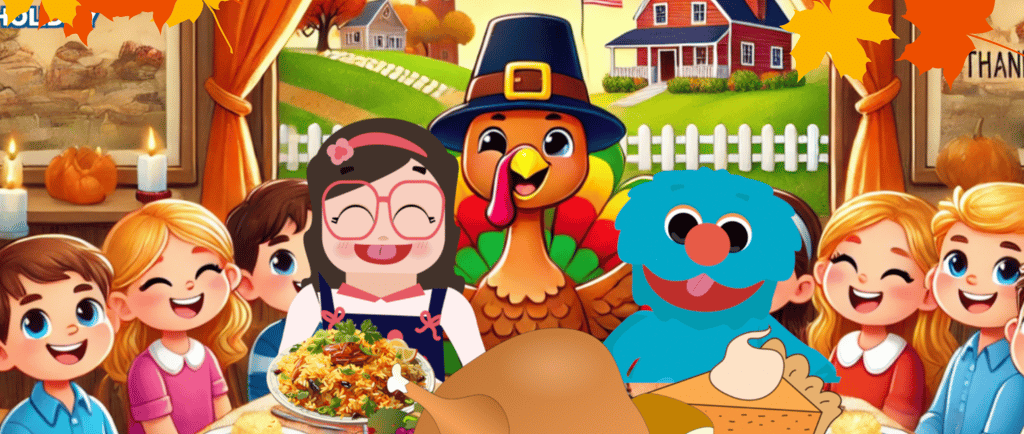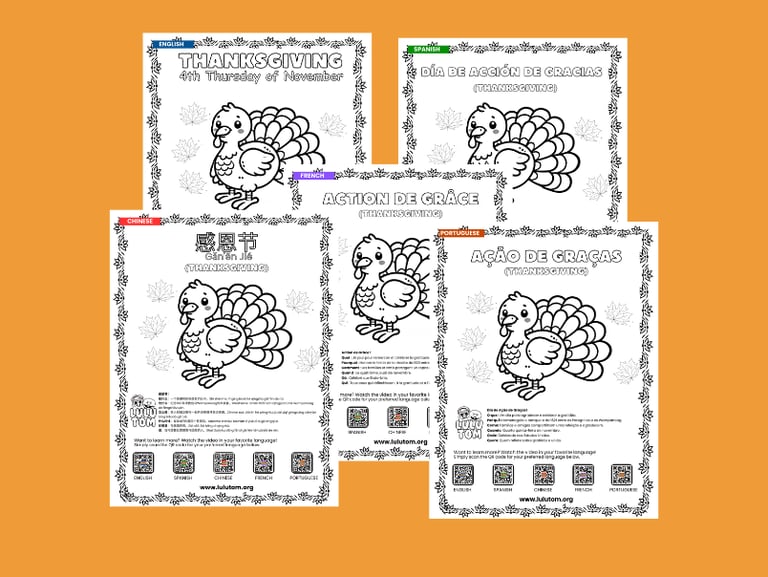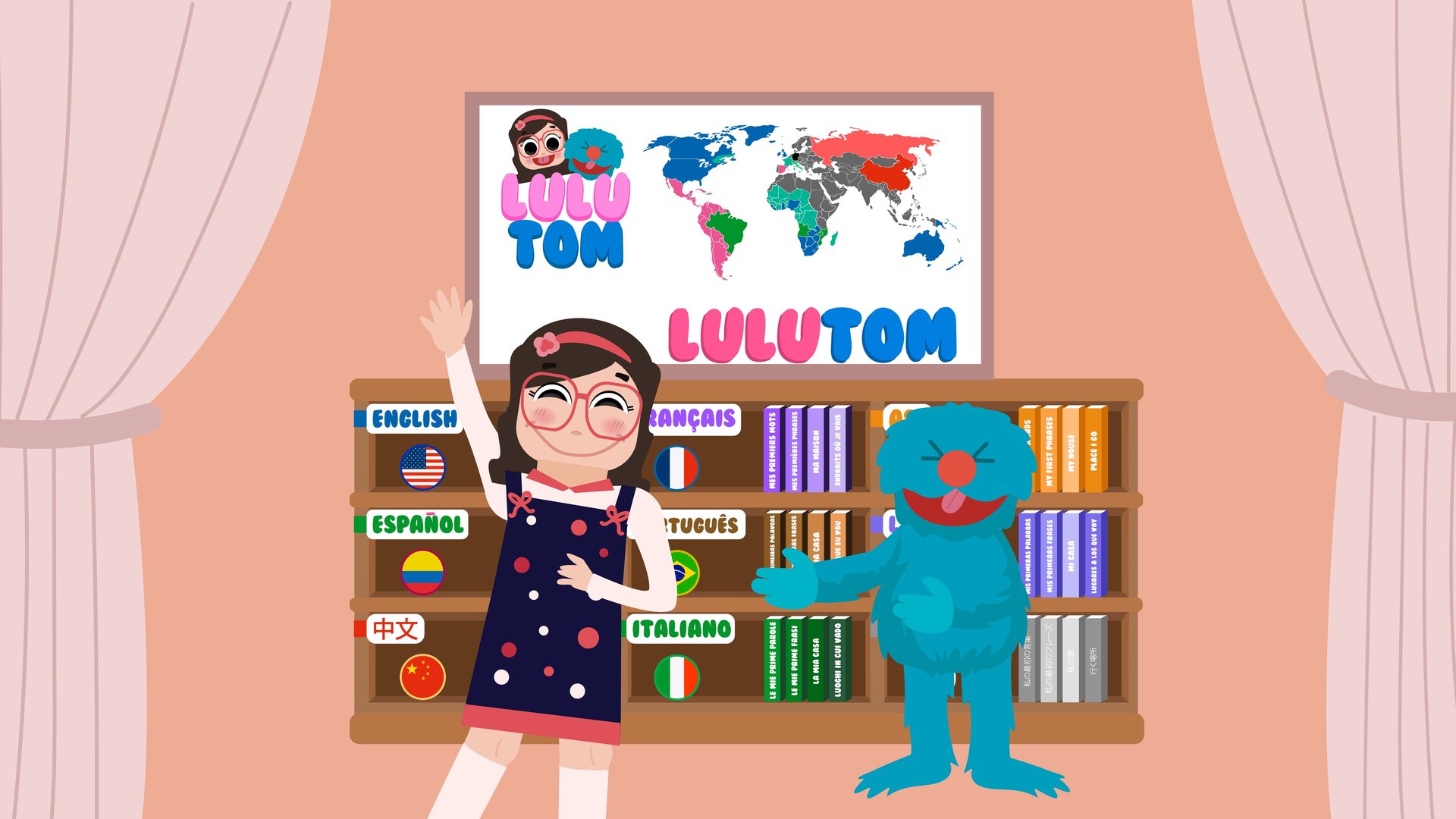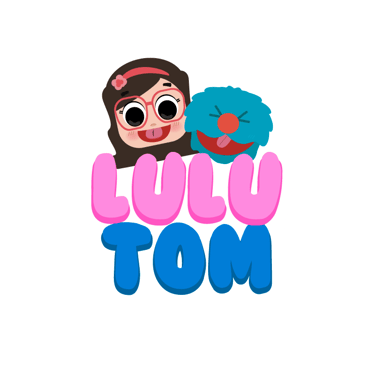The Importance of Teaching Our Children About Thanksgiving and the Spirit of Gratitude
Luisa Betancourt Weinstein
11/21/202413 min read


As Thanksgiving approaches, it offers us a unique opportunity to teach our children about gratitude, togetherness, and the history of a holiday that transcends borders and cultures. Whether we are Americans or not, the real soul of Thanksgiving—a celebration of gratitude and kindness—is something everyone can embrace and learn from.
Why Teach Our Children About Thanksgiving?
Thanksgiving is more than a day for turkey and pumpkin pie. It’s a time to pause, reflect, and express gratitude for the good things in life. Teaching children about Thanksgiving helps them:
Develop Gratitude: Learning about Thanksgiving can help children recognize the importance of saying "thank you" and appreciating the people and blessings in their lives.
Understand History: The story of the Pilgrims and Native Americans highlights themes of cooperation, kindness, and friendship.
Celebrate Inclusivity: Thanksgiving traditions remind us of the value of coming together, regardless of differences, to share and give thanks.
Gratitude is universal and timeless, making this holiday a valuable lesson for children, regardless of where they live or their cultural background.
Activities to Teach Children About Thanksgiving
Engaging children with hands-on activities helps them connect with the lessons of Thanksgiving in a meaningful and enjoyable way. Here are some updated ideas:
Gratitude Lists
Encourage your children to list things they are thankful for. This can become a yearly tradition, fostering reflection and gratitude for the blessings in their lives.Interactive Art Projects
Create crafts like gratitude trees, thank-you cards, or festive decorations for Thanksgiving. These activities provide a creative way for kids to express their appreciation and learn about the holiday.Cooking Together
Invite your children to help prepare traditional dishes such as mashed potatoes, pumpkin pie, or even culturally significant family recipes. This teaches them about the importance of shared meals and family traditions.Story Time and Language Exploration
Read books or watch videos that explain the history and traditions of Thanksgiving. For a multilingual twist, use resources like the LuluTom Thanksgiving Guide to read along with scripts in various languages and explore the holiday from a global perspective.Coloring and Creative Printables
Engage kids with free Thanksgiving-themed printables that include coloring activities, vocabulary building, and reflection prompts. They can learn while having fun!Community Giving
Teach children the importance of kindness and generosity by volunteering at local charities, donating food, or creating care packages for those in need.Watch, Read, and Explore Together
Watch engaging Thanksgiving videos, read along with the scripts, and explore the holiday in multiple languages. Use QR codes to make the experience interactive and exciting for young learners.
By combining creativity, learning, and acts of kindness, these activities make Thanksgiving an enriching experience for children while teaching valuable lessons about gratitude and togetherness.
Free Thanksgiving Printable in Five Languages!
To make Thanksgiving even more meaningful for children, I’ve created a free printable resource available in English, Spanish, French, Portuguese, and Chinese. This activity is designed to:
Help children reflect on what they’re thankful for.
Teach key Thanksgiving vocabulary.
Provide fun activities that align with the holiday’s themes.


Gratitude Is for Everyone
Thanksgiving reminds us that gratitude has no borders. Whether or not we celebrate this holiday as Americans, its values—kindness, thankfulness, and togetherness—are universal. By teaching our children about Thanksgiving, we instill in them an appreciation for life's blessings and the importance of giving back.
Let’s celebrate the spirit of Thanksgiving together, no matter where we are in the world. Download the free printable, explore our multilingual videos, and share the gift of gratitude with your family.
Explore Thanksgiving in Multiple Languages
As part of LuluTom’s mission to teach my children about the world through multiple languages, I’ve created Thanksgiving videos in English, Spanish, French, Portuguese, and Chinese. These videos are perfect for families raising multilingual children, classrooms, or anyone curious about learning in a new language.


ENGLISH
SPANISH
CHINESE
FRENCH
PORTUGUESE
📺 Watch the videos on our LuluTom language channels or go ahead JOIN THE STORY WITH LULUTOM!!!!
JOIN THE STORY WITH LULUTOM'S Complete Thanksgiving Guide: Watch, Read, Color, Review, and Explore Thanksgiving Across Languages (in ENGLISH, SPANISH, CHINESE, FRENCH, AND PORTUGUESE), just one click away and completely free!



JOIN OUR THANKSGIVING STORY!
READ ALONG WITH LULU AND TOM
The Complete LuluTom Guide: Watch, Read, Color, Review, and Explore Thanksgiving Across Languages!
Dive into the spirit of Thanksgiving with our interactive resources and insightful blog:
Watch our engaging video about Thanksgiving.
Read along with the scripts below (English, Spanish, Chinese, French and Portuguese) to enhance comprehension.
Color and enjoy creative activities with our free printable.
Review the key takeaways with a concise summary in the printable.
Explore Thanksgiving in multiple languages using QR codes included in the resources.
Learn more about the history, values, and activities of Thanksgiving by reading our blog, which highlights the universal importance of gratitude, togetherness, and inclusivity.
Perfect for learning and fun at any age—bring the joy of Thanksgiving to life in English, Spanish, French, Chinese, Portuguese, and more!
Tom: What are you doing Lulu?
Lulu: I am getting ready to celebrate Thanksgiving
Tom: What? Thanksgiving?
Narrator: Thanksgiving is a holiday observed in the United States, where we say thank you for all the good things in our lives.
Every year, on the fourth Thursday of November, families and friends gather together to enjoy a big, delicious meal and to be thankful for everything good in their lives.
Lulu: Thankful? What does that mean?"
Narrator: Being thankful means feeling happy about what we have and the people who make us smile. Imagine how you feel when someone helps you or makes you feel special—it’s like saying 'Thank you' but in your heart.
Tom: So… Thanksgiving is about saying thanks?
Narrator: Yes, Tom! And Thanksgiving has a long history that goes back hundreds of years.
In 1621, a group of people called the Pilgrims traveled all the way from England to America. But when they arrived, they didn’t know how to find food or stay warm through the cold months.
Lulu: Oh no, that sounds scary!
Narrator: It was tough! But the Native Americans, especially a group called the Wampanoag, noticed the Pilgrims were struggling. They decided to help them by teaching them how to plant corn, hunt, and gather food. With the Wampanoag’s help, the Pilgrims survived their first year and had a big harvest the next year.
Tom: They became friends?
Narrator: Yes! And to celebrate their friendship and the successful harvest, the Pilgrims invited the Wampanoag to share a feast. It was a huge meal, just like Thanksgiving is today. That meal started the tradition of Thanksgiving, a day to remember kindness and to be grateful for the good things in life.
Lulu: So, Thanksgiving is about friends and family helping each other?
Narrator: That’s exactly it, Lulu. Nowadays, families come together and eat foods like roasted turkey, mashed potatoes, cranberry sauce, and pumpkin pie. They go around the table and share what they’re thankful for.
Tom: I’d say thank you for pie!
Narrator: Yes, pumpkin pie is a big favorite! But people also say thank you for family, friends, their cozy homes, or anything else that makes them happy. Sometimes, friends get together and call it 'Friendsgiving,' so everyone can celebrate, even if they’re far from family.
Lulu: That sounds fun! So, we could have our own Thanksgiving with friends?
Narrator: Absolutely! Thanksgiving reminds us that every good thing is worth celebrating. And being with people who care about us—whether family or friends—is what makes the holiday so special.
Tom: I think I’d like that. We could make a list of everything we love!
Narrator: Exactly, Tom! So this Thanksgiving, try making a list of things that make you feel grateful. It’s a simple way to remember what’s truly important.
Lulu: I’m thankful for you, Narrator, and my friend Tom!
Tom: And I’m thankful for you, Lulu! And, of course, for all the pie!

THANKSGIVING IN ENGLISH:
Watch, Read, Color, Review, Explore & Learn More
WATCH:
READ ALONG:
COLOR, REVIEW AND EXPLORE:
LEARN MORE:


Tom: ¿Qué estás haciendo, Lulu?
Lulu: Me estoy preparando para celebrar el Día de Acción de Gracias.
Tom: ¿Qué? ¿Día de Acción de Gracias?
Narrador: El Día de Acción de Gracias es un feriado celebrado en los Estados Unidos, donde decimos gracias por todas las cosas buenas en nuestras vidas.
Cada año, el cuarto jueves de noviembre, las familias y amigos se reúnen para disfrutar de una gran comida deliciosa y estar agradecidos por todo lo bueno en sus vidas.
Lulu: ¿Agradecidos? ¿Qué significa eso?
Narrador: Estar agradecido significa sentirse feliz por lo que tenemos y por las personas que nos hacen sonreír. Imagina cómo te sientes cuando alguien te ayuda o te hace sentir especial, es como decir 'Gracias', pero desde el corazón.
Tom: Entonces... ¿el Día de Acción de Gracias es sobre dar gracias?
Narrador: ¡Sí, Tom! Y el Día de Acción de Gracias tiene una larga historia que se remonta a cientos de años. En 1621, un grupo de personas llamadas los Peregrinos viajaron desde Inglaterra hasta América. Pero cuando llegaron, no sabían cómo encontrar comida ni mantenerse calientes durante los meses fríos.
Lulu: ¡Oh no, eso suena aterrador!
Narrador: ¡Fue difícil!
Pero un grupo de nativos americanos, llamados los Wampanoag, se dieron cuenta de que los Peregrinos estaban luchando. Decidieron ayudarlos enseñándoles cómo plantar maíz, cazar y recolectar alimentos.
Con la ayuda de los Wampanoag, los Peregrinos sobrevivieron su primer año y tuvieron una gran cosecha al año siguiente.
Tom: ¿Se hicieron amigos?
Narrador: ¡Sí!
Y para celebrar su amistad y la exitosa cosecha, los Peregrinos invitaron a los Wampanoag a compartir un festín.
Fue una gran comida, tal como el Día de Acción de Gracias de hoy.
Esa comida comenzó la tradición de Acción de Gracias, un día para recordar la bondad y ser agradecidos por las cosas buenas de la vida.
Lulu: Entonces, ¿el Día de Acción de Gracias se trata de amigos y familia ayudándose mutuamente?
Narrador: ¡Exactamente! Hoy en día, las familias se reúnen y comen platos como pavo asado, puré de papas, salsa de arándanos y pastel de calabaza.
Van alrededor de la mesa y comparten por qué están agradecidos.
Tom: ¡Yo diría gracias por el pastel!
Narrador: ¡Sí, el pastel de calabaza es un gran favorito!
Pero también la gente dice gracias por la familia, los amigos, su hogar acogedor o cualquier otra cosa que los haga felices.
A veces, los amigos se reúnen y lo llaman 'Friendsgiving', para que todos puedan celebrar, incluso si están lejos de la familia.
Lulu: ¡Eso suena divertido! Entonces, ¿podemos tener nuestro propio Día de Acción de Gracias con amigos?
Narrador: ¡Absolutamente! El Día de Acción de Gracias nos recuerda que cada cosa buena vale la pena ser celebrada. Y estar con las personas que se preocupan por nosotros — ya sea familia o amigos — es lo que hace que el feriado sea tan especial.
Tom: Creo que me gustaría eso. ¡Podríamos hacer una lista de todo lo que amamos!
Narrador: ¡Esa es una gran idea, Tom! Así que este Día de Acción de Gracias, trata de hacer una lista de las cosas por las que te sientes agradecido.
Es una manera simple de recordar lo que realmente importa.
Lulu: ¡Estoy agradecida por ti, Tom!
Tom: ¡Y yo estoy agradecido por ti, Lulu! Y, por supuesto, por todo el pastel.
Lulu: ¿Y tú? ¿Por qué estás agradecido?

THANKSGIVING IN SPANISH:
Watch, Read, Color, Review, Explore & Learn More
WATCH:
READ ALONG:
COLOR, REVIEW AND EXPLORE:
LEARN MORE:


Tom:Lulu,你在做什么?
Lulu:我正在准备庆祝感恩节。
Tom:什么?感恩节?
旁白:感恩节是美国的一个节日,我们会为生活中的所有美好事物表示感谢。每年,十一月的第四个星期四,家人和朋友们会聚在一起,享受一顿丰盛的美食,并为生活中的一切美好而感恩。
Lulu: 感恩?那是什么意思?
旁白: 感恩是指对我们拥有的东西和让我们微笑的人感到幸福。想象一下,当有人帮助你或让你觉得特别时的感觉——就像在心里对他们说‘谢谢’。
Tom: 所以……感恩节是关于说谢谢的吗?
旁白: 是的,Tom!感恩节有着数百年的悠久历史。1621年,一群被称为清教徒的人从英国一路航行到美国。但是当他们到达时,他们不知道如何找到食物或在寒冷的冬天保暖
Lulu: 哦,不,这听起来很可怕!
旁白: 确实很困难!但是一个叫Wampanoag的美洲原住民部落发现了清教徒的困境。他们决定帮助清教徒,教他们如何种植玉米、打猎和采集食物。
在Wampanoag的帮助下,清教徒度过了他们的第一年,并在第二年获得了丰收。
Tom: 他们成了朋友吗?
旁白: 是的!为了庆祝他们的友谊和丰收,清教徒邀请了Wampanoag一起参加盛宴。这是一顿丰盛的餐宴,就像今天的感恩节。
那顿饭开始了感恩节的传统,一个纪念善良并对生活中美好事物心存感激的日子。
Lulu: 所以,感恩节是关于朋友和家人互相帮助的吗?
旁白: “完全正确!现在,家人们聚在一起吃火鸡、土豆泥、蔓越莓酱和南瓜派。他们围坐在桌子旁,分享他们的感恩之情。
Tom: 我会感谢派!
旁白: 是的,南瓜派是大热门!但是人们也感谢家人、朋友、舒适的家,或者任何让他们开心的事情。
有时朋友们聚在一起,把它叫做‘友谊感恩节’,这样即使离家很远,大家也能庆祝。
Lulu: 听起来很有趣!那我们可以和朋友一起过自己的感恩节吗?
旁白: 当然可以!感恩节提醒我们,生活中的每件好事都值得庆祝。和关心我们的人——无论是家人还是朋友——在一起,就是这个节日的特别之处。
Tom: 我觉得我会喜欢的。我们可以列一张清单,把我们喜欢的一切写下来!
旁白: 这是个好主意,Tom!今年感恩节试试写一张让你感到感激的事物清单吧。这是一种简单的方法,可以帮助我们记住真正重要的东西。
Lulu: 我很感激你,Tom!
Tom: 我也很感激你,Lulu!当然,还有所有的派!
Lulu: 你呢?你感激什么?

THANKSGIVING IN CHINESE:
Watch, Read, Color, Review, Explore & Learn More
WATCH:
READ ALONG:
COLOR, REVIEW AND EXPLORE:
LEARN MORE:


(hi! It is Luisa, I will be adding pinyin soon :))
Tom : Que fais-tu, Lulu ?
Lulu : Je me prépare à célébrer Thanksgiving.
Tom : Quoi ? Thanksgiving ?
Narrateur : Thanksgiving est une fête célébrée aux États-Unis, où nous disons merci pour toutes les bonnes choses de notre vie. Chaque année, le quatrième jeudi de novembre, les familles et les amis se réunissent pour partager un grand repas délicieux et être reconnaissants pour tout ce qui est bon dans leur vie.
Lulu : Reconnaissants ? Qu'est-ce que ça veut dire ?
Narrateur : Être reconnaissant signifie se sentir heureux de ce que nous avons et des personnes qui nous font sourire. Imagine ce que tu ressens quand quelqu'un t'aide ou te fait te sentir spécial – c'est comme dire 'Merci' mais dans ton cœur.
Tom : Alors… Thanksgiving, c'est pour dire merci ?
Narrateur : Oui, Tom ! Et Thanksgiving a une longue histoire qui remonte à des centaines d'années. En 1621, un groupe de personnes appelées les Pèlerins a voyagé depuis l'Angleterre jusqu'en Amérique. Mais quand ils sont arrivés, ils ne savaient pas comment trouver de la nourriture ou rester au chaud pendant les mois d'hiver.
Lulu : Oh non, ça semble effrayant !
Narrateur : C'était difficile ! Mais un groupe d'Amérindiens, appelés les Wampanoag, a remarqué que les Pèlerins avaient du mal. Ils ont décidé de les aider en leur apprenant à planter du maïs, à chasser et à récolter de la nourriture. Grâce à l'aide des Wampanoag, les Pèlerins ont survécu à leur première année et ont eu une grande récolte l'année suivante.
Tom : Ils sont devenus amis ?
Narrateur : Oui ! Et pour célébrer leur amitié et la récolte réussie, les Pèlerins ont invité les Wampanoag à partager un festin. C'était un énorme repas, tout comme Thanksgiving aujourd'hui. Ce repas a lancé la tradition de Thanksgiving, un jour pour se souvenir de la gentillesse et être reconnaissant pour les bonnes choses de la vie.
Lulu : Alors, Thanksgiving, c'est pour que les amis et la famille s'entraident ?
Narrateur : Exactement. De nos jours, les familles se réunissent et mangent des plats comme de la dinde rôtie, de la purée de pommes de terre, de la sauce aux canneberges et de la tarte à la citrouille. Ils font le tour de la table et partagent pour quoi ils sont reconnaissants.
Tom : Moi, je dirais merci pour la tarte !
Narrateur : Oui, la tarte à la citrouille est un grand favori ! Mais les gens disent aussi merci pour leur famille, leurs amis, leur maison confortable ou toute autre chose qui les rend heureux. Parfois, les amis se réunissent et appellent cela 'Friendsgiving', pour que tout le monde puisse célébrer, même loin de sa famille.
Lulu : Ça a l'air amusant ! Alors, on pourrait faire notre propre Thanksgiving avec des amis ?
Narrateur : Absolument ! Thanksgiving nous rappelle que chaque bonne chose mérite d'être célébrée. Et être avec des personnes qui se soucient de nous – que ce soit la famille ou les amis – est ce qui rend cette fête si spéciale.
Tom : Je pense que j'aimerais ça. On pourrait faire une liste de tout ce qu'on aime !
Narrateur : C'est une excellente idée, Tom ! Alors, ce Thanksgiving, essayez de faire une liste des choses pour lesquelles vous vous sentez reconnaissant. C'est une façon simple de se souvenir de ce qui est vraiment important.
Lulu : Je suis reconnaissante pour toi, Tom !
Tom : Et je suis reconnaissant pour toi, Lulu ! Et, bien sûr, pour toutes les tartes !
Lulu : Et toi ? Pourquoi es-tu reconnaissant ?

THANKSGIVING IN FRENCH:
Watch, Read, Color, Review, Explore & Learn More
WATCH:
READ ALONG:
COLOR, REVIEW AND EXPLORE:
LEARN MORE:


Tom: O que você está fazendo, Lulu?
Lulu: Estou me preparando para celebrar o Dia de Ação de Graças.
Tom: O quê? Dia de Ação de Graças?
Narrador: O Dia de Ação de Graças é um feriado celebrado nos Estados Unidos, onde dizemos obrigado por todas as coisas boas em nossas vidas.
Todo ano, na quarta quinta-feira de novembro, as famílias e amigos se reúnem para compartilhar uma grande refeição deliciosa e serem gratos por tudo de bom em suas vidas.
Lulu: Gratos? O que isso significa?
Narrador: Ser grato significa sentir-se feliz pelo que temos e pelas pessoas que nos fazem sorrir. Imagine como você se sente quando alguém te ajuda ou te faz sentir especial — é como dizer 'Obrigado', mas no coração.
Tom: Então... o Dia de Ação de Graças é sobre dizer obrigado?
Narrador: Sim, Tom! E o Dia de Ação de Graças tem uma longa história que remonta a centenas de anos. Em 1621, um grupo de pessoas chamado os Peregrinos viajou da Inglaterra para a América. Mas quando chegaram, não sabiam como encontrar comida ou se aquecer durante os meses frios."
Lulu: Ah não, isso parece assustador!
Narrador: Foi difícil! Mas um grupo de nativos americanos, chamado Wampanoag, percebeu que os Peregrinos estavam com dificuldades. Eles decidiram ajudar, ensinando-os a plantar milho, caçar e coletar alimentos.
Com a ajuda dos Wampanoag, os Peregrinos sobreviveram ao primeiro ano e tiveram uma grande colheita no ano seguinte."
Tom: Eles se tornaram amigos?
Narrador: Sim! E para celebrar a amizade e a colheita bem-sucedida, os Peregrinos convidaram os Wampanoag para compartilhar um grande banquete. Foi uma grande refeição, como o Dia de Ação de Graças de hoje. Essa refeição iniciou a tradição do Dia de Ação de Graças, um dia para lembrar a bondade e sermos gratos pelas boas coisas da vida."
Lulu: Então, o Dia de Ação de Graças é sobre amigos e famílias se ajudando?
Narrador: "Isso mesmo. Hoje em dia, as famílias se reúnem e comem pratos como peru assado, purê de batata, molho de cranberry e torta de abóbora.
Eles vão ao redor da mesa e compartilham o que estão agradecendo."
Tom: Eu diria obrigado pela torta!
Narrador: "Sim, torta de abóbora é um grande favorito! Mas as pessoas também agradecem pela família, pelos amigos, pela casa acolhedora ou por qualquer outra coisa que as faça felizes.
Às vezes, amigos se reúnem e chamam de 'Friendsgiving', para que todos possam celebrar, mesmo estando longe da família."
Lulu: Isso parece divertido! Então, podemos fazer o nosso próprio Dia de Ação de Graças com amigos?
Narrador: Claro! O Dia de Ação de Graças nos lembra que toda boa coisa vale a pena ser celebrada. E estar com pessoas que se importam conosco — seja família ou amigos — é o que torna o feriado tão especial."
Tom: Eu acho que gostaria disso. Podemos fazer uma lista de tudo que amamos!
Narrador: Ótima ideia, Tom! Então, neste Dia de Ação de Graças, tente fazer uma lista de coisas pelas quais você é grato. É uma maneira simples de lembrar o que realmente importa."
Lulu: Eu sou grata por você, Tom!
Tom: E eu sou grato por você, Lulu! E, claro, por toda a torta!
Lulu: E você? Pelo que você é grato?

THANKSGIVING IN PORTUGUESE:
Watch, Read, Color, Review, Explore & Learn More
WATCH:
READ ALONG:
COLOR, REVIEW AND EXPLORE:
LEARN MORE:



